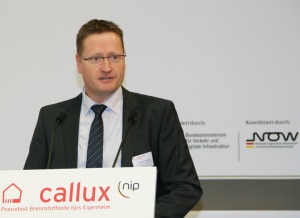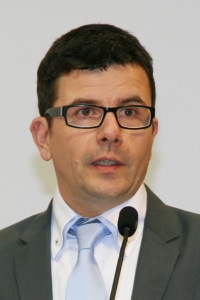Despite the fact that the envisioned number of 800 fuel cell heating systems was not even close to have been achieved, there was a lot of praise going around when the partners of the Callux project celebrated the completion of the Field Test of Residential Fuel Cells on Nov. 26, 2015. In the Erich Klausener Hall at the Federal Ministry of Transport and Digital Infrastructure (BMVI) in Berlin, Parliamentary State Secretary Norbert Barthle said Callux was “highly gratifying – a wonderful project.”
The final event started with a short movie in which the project partners and many satisfied customers of the test run extolled the virtues of the new technology. Immediately thereafter, Barthle explained in his opening speech in reference to these “testimonials” – at least, that is what he called the ad clips – and the seven-year field test: “This project has brought together companies usually seen as competitors. […] In my view, the results speak for themselves.”
No to costs, yes to availability
Callux was introduced at the same location in September 2008 as the first pioneering project of the National Innovation Programme Hydrogen and Fuel Cell Technology (NIP) with the aim of installing 800 fuel cell units outside of the lab by 2015. The project, which ran from July 1, 2008, to June 30, 2015, led to various technological advancements as well as many, many experiences based on over 5 million operational hours.
System costs were cut down by 60% over three generations; both manufacturers and technicians were trained to boost unit availability to above 96%. Electric efficiency is now up to over 33%. All in all, the project created more than 3 million kilowatt-hours of electricity. One system alone saves one to two tons of carbon dioxide per year, depending on the type of building.
The criticism lodged against the project and the “mere around 500” units that were actually installed was rejected by Barthle: “Such complaints don’t consider the bigger picture.” He said that the federal government supported research into any technology, but that ultimately “marketing is the companies’ business.” The market decided what would win over customers in the end. Dr. Klaus Bonhoff, CEO of NOW, also stressed the project’s successes: “Despite the total number not matching target figures, the 1,000 units installed make Germany the leader in Europe.” He even went as far as saying that, “NIP paved the way for an accelerated market introduction.”
In retrospect
“The consortium partners are optimistic that the first stage of the project until 2012 will already result in so many fuel cell heating installations across Germany that the second stage can be used to start market rollout.” (Callux press release from 2008)
Regarding Japan and the much more than 100,000 systems in operation there, NOW’s President provided the following – very brief – explanation: “Competition is good for business.” A similarly short reply was given by the Callux spokesperson when H2-international asked him why the mark of 500 fuel cell heating systems had already been mentioned in an announcement last spring: “The number was rounded up. That’s nothing unusual.”
Many setbacks
Conversely, Alexander Dauensteiner, spokesperson and Head of Product Management Innovation at Vaillant, talked about the “many, many setbacks,” but insisted that the “fuel cell is the right device at the right time.” Afterward, he again used the metaphor of a marathon run, during which “you’ll need someone to provide you with that cereal bar and that glass of water.” What he was referring to was the BMVI’s financial support, which could be better compared to Thanksgiving turkey and Christmas cider than to bread and water, to stay with the image. Overall, the government threw EUR 75 million at the project, EUR 36 million of which were grants.
After 474 systems have now been in operation for an average of two to three years each, the Callux partners expect installation figures to increase to 26,000 by 2020, and even to 165,000 by 2025. This kind of growth, however, would require 1,500 fuel cell units in operation until the end of 2016.
Whether this is a realistic goal will depend mainly on how the expected technology rollout program is implemented (see interview). Barthle was confident that it would be achieved: “We are at the beginning of commercial market entry.”



























0 Comments